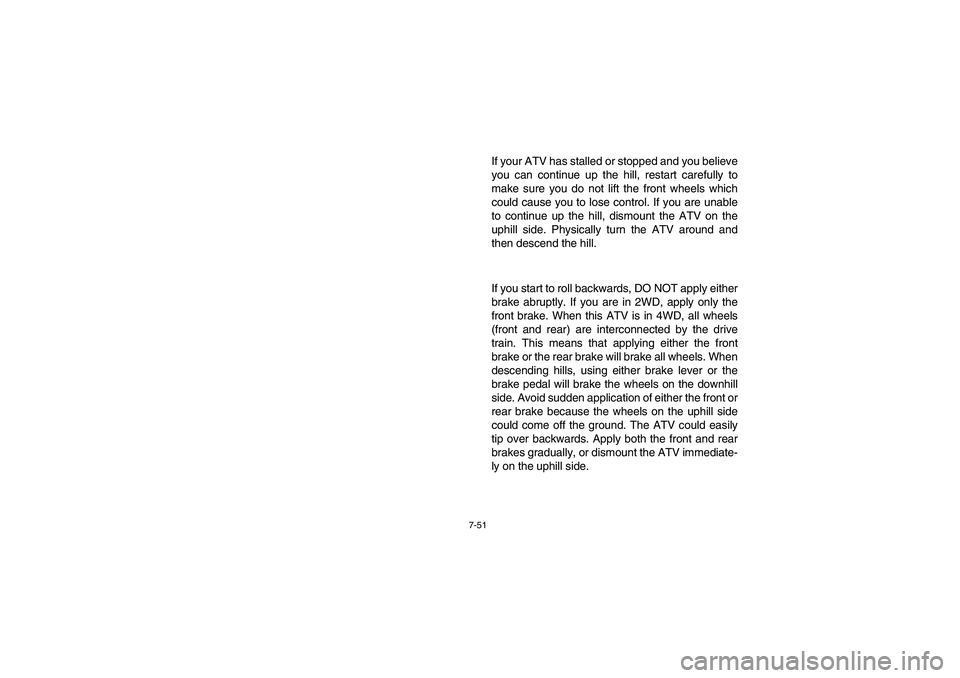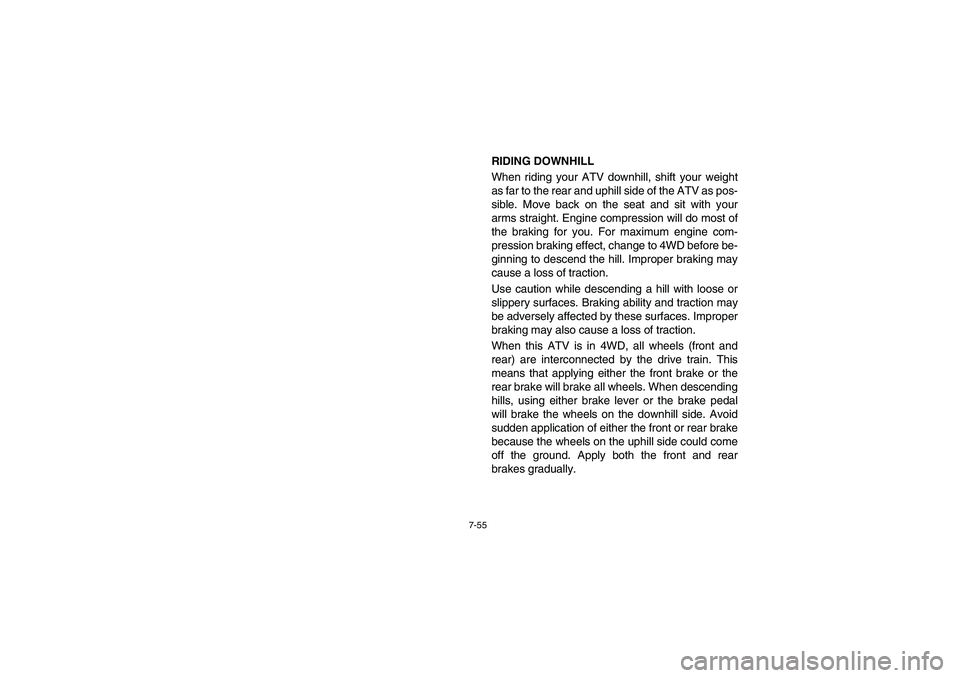Page 166 of 426
6-21
EBU00216
Parking on a slope
WARNING
_ Avoid parking on hills or other inclines. Park-
ing on a hill or other incline could cause the
ATV to roll out of control, increasing the
chance of an accident. If you must park on an
incline, place the machine transversely across
the incline, apply the parking brake, and block
the front and rear wheels with rocks or other
objects. Do not park the ATV at all on hills that
are so steep you could not walk up them easi-
ly. _1. Bring the machine to a stop by applying the
brakes.
2. Stop the engine.
3. With the rear brake applied, apply the parking
brake.
U5TE60.book Page 21 Monday, June 10, 2002 8:47 AM
Page 212 of 426
7-35
Select a large, flat area off-road to become familiar
with your ATV. Make sure that this area is free of
obstacles and other riders. You should practice
control of the throttle, brakes, and turning tech-
niques in this area before trying more difficult ter-
rain. Always avoid riding on paved surfaces: the
ATV is designed for off-road use only, and han-
dling maneuvers are more difficult to perform on
pavement.
Set the parking brake and follow the instructions
on page 6-3 to start the engine. Once it has
warmed up you are ready to begin riding your
ATV. Remember that the engine and exhaust pipe
will be hot when riding and afterwards; do not al-
low skin or clothing to come in contact with these
components.
U5TE60.book Page 35 Monday, June 10, 2002 8:47 AM
Page 214 of 426
7-37
With the engine idling, shift the drive select lever
into the forward “FWD” position. Apply the throttle
slowly and smoothly. The centrifugal clutch will en-
gage and you will start to accelerate. If the throttle
is applied too abruptly, the front wheels may lift off
the ground resulting in a loss of directional control.
Avoid higher speeds until you are thoroughly famil-
iar with the operation of your ATV.
When slowing down or stopping, release the throt-
tle and apply the brakes smoothly and evenly. Im-
proper use of the brakes can cause the tires to
lose traction, reducing control and increasing the
possibility of an accident.
U5TE60.book Page 37 Monday, June 10, 2002 8:47 AM
Page 228 of 426

7-51
If your ATV has stalled or stopped and you believe
you can continue up the hill, restart carefully to
make sure you do not lift the front wheels which
could cause you to lose control. If you are unable
to continue up the hill, dismount the ATV on the
uphill side. Physically turn the ATV around and
then descend the hill.
If you start to roll backwards, DO NOT apply either
brake abruptly. If you are in 2WD, apply only the
front brake. When this ATV is in 4WD, all wheels
(front and rear) are interconnected by the drive
train. This means that applying either the front
brake or the rear brake will brake all wheels. When
descending hills, using either brake lever or the
brake pedal will brake the wheels on the downhill
side. Avoid sudden application of either the front or
rear brake because the wheels on the uphill side
could come off the ground. The ATV could easily
tip over backwards. Apply both the front and rear
brakes gradually, or dismount the ATV immediate-
ly on the uphill side.
U5TE60.book Page 51 Monday, June 10, 2002 8:47 AM
Page 230 of 426
7-53
WARNING
_ Maintain steady speed when climbing a hill.
If you lose all forward speed: �
Keep weight uphill.
�
Apply the brakes.
�
Apply the parking brake after you are
stopped.
If you begin rolling backwards:
�
Keep weight uphill.
�
2WD: Never apply the rear brake while roll-
ing backwards. Apply the front brake.
4WD: Apply both front and rear brakes
gradually.
When fully stopped, apply the parking
brake.
Dismount on uphill side or to a side if pointed
straight uphill. Turn the ATV around and re-
mount, following the procedure described in
the Owner’s Manual.
_
U5TE60.book Page 53 Monday, June 10, 2002 8:47 AM
Page 232 of 426

7-55
RIDING DOWNHILL
When riding your ATV downhill, shift your weight
as far to the rear and uphill side of the ATV as pos-
sible. Move back on the seat and sit with your
arms straight. Engine compression will do most of
the braking for you. For maximum engine com-
pression braking effect, change to 4WD before be-
ginning to descend the hill. Improper braking may
cause a loss of traction.
Use caution while descending a hill with loose or
slippery surfaces. Braking ability and traction may
be adversely affected by these surfaces. Improper
braking may also cause a loss of traction.
When this ATV is in 4WD, all wheels (front and
rear) are interconnected by the drive train. This
means that applying either the front brake or the
rear brake will brake all wheels. When descending
hills, using either brake lever or the brake pedal
will brake the wheels on the downhill side. Avoid
sudden application of either the front or rear brake
because the wheels on the uphill side could come
off the ground. Apply both the front and rear
brakes gradually.
U5TE60.book Page 55 Monday, June 10, 2002 8:47 AM
Page 240 of 426
7-63
CROSSING THROUGH SHALLOW WATER
The ATV can be used to cross slow moving, shal-
low water of up to a maximum of 35 cm in depth.
Before entering the water, choose your path care-
fully. Enter where there is no sharp drop off, and
avoid rocks or other obstacles which may be slip-
pery or upset the ATV. Drive slowly and carefully.
WARNING
_ Never operate this ATV in fast flowing water or
in water deeper than that specified in your
Owner’s Manual. Remember that wet brakes
may have reduced stopping ability. Test your
brakes after leaving water. If necessary, apply
them several times to let friction dry out the lin-
ings. If the ATV is operated through deep or
fast flowing water, the tires may float, causing
loss of traction and loss of control, which
could lead to an accident. _
U5TE60.book Page 63 Monday, June 10, 2002 8:47 AM
Page 242 of 426
7-65
1. Air filter case check hose
1. Flexible de contrôle du boîtier de filtre à air
1. Manguera de comprobación de la caja del filtro de aire
Test your brakes after leaving the water. Do not
continue to ride your ATV without verifying that
you have regained proper braking ability.CAUTION:_ After riding your ATV in water, be sure to drain
the trapped water by removing the check hose
at the bottom of the air filter case and the
check hose on the V-belt cooling duct. Wash
the ATV in fresh water if it has been operated in
salt water or muddy conditions. _
U5TE60.book Page 65 Monday, June 10, 2002 8:47 AM